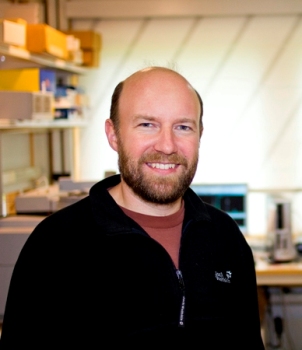Nov 28 2015
Global warming will progress faster than what was previously believed. The reason is that greenhouse gas emissions that arise naturally are also affected by increased temperatures. This has been confirmed in a new study from Linköping University that measures natural methane emissions.
 David Bastviken
David Bastviken
“Everything indicates that global warming caused by humans leads to increased natural greenhouse gas emissions. Our detailed measurements reveal a clear pattern of greater methane emissions from lakes at higher temperatures,” says Sivakiruthika Natchimuthu, doctoral student at Tema Environmental Change, Linköping University, Sweden, and lead author of the latest publication on this topic from her group.
Over the past two years the research team at Linköping University has contributed to numerous studies that all point in the same direction: natural greenhouse gas emissions will increase when the climate gets warmer. In the latest study the researchers examined the emissions of the greenhouse gas methane from three lakes. The effects were clear and the methane emissions increased exponentially with temperature. Their measurements show that a temperature increase from 15 to 20 degrees Celsius almost doubled the methane level. The findings was recently published in Limnology and Oceanography.
While increased anthropogenic emissions of greenhouse gases are expected and included in climate predictions, the future development of the natural emissions has been less clear.
Now knowledge of a vicious circle emerge: greenhouse gas emissions from the burning of fossil fuels lead to higher temperatures, which in turn lead to increased natural emissions and further warming.

Exponential relationship of lake average total CH4 fluxes from all depths with average water (a,b,c) and air temperature (d,e,f). Open circles denote data from 2012 and closed circles. The arrows indicate data during the low pressure event in September, 2013. ERS, FJS and SKS denote Erssjön, Följesjön and Skottenesjön respectively. The water temperature was measured frequently and averaged over the deployment period in Erssjön and Följesjön. In Skottenesjön water temperature was measured during start and stop of deployment only, which could explain the stronger relationship with air temperature than the water temperature.
“We’re not talking about hypotheses anymore. The evidence is growing and the results of the detailed studies are surprisingly clear. [DB1] The question is no longer if the natural emissions will increase but rather how much they will increase with warming,” says David Bastviken, professor at Tema Environmental Change, Linköping University.
This means that warming will be faster than expected from anthropogenic greenhouse gas emissions alone. According to Professor Bastviken this also means that any reductions in anthropogenic greenhouse emissions is a double victory, by both reducing the direct effect on warming, but also by preventing the feedback with increased natural emissions.
Latest publication:
Natchimuthu S, Sundgren I, Gålfalk M, Klemedtsson L, Crill P, Danielsson Å, Bastviken D. 2015. Spatio-temporal variability of lake CH4 fluxes and its influence on annual whole lake emission estimates. Limnology and Oceanography. doi: 10.1002/lno.10222.
Other recent papers:
Marotta H, Pinho LQ, Gudasz C. Bastviken D, Tranvik L, Enrich-Prast A. 2014. Greenhouse gas production in low latitude lake sediments responds strongly to warming. Nature Climate Change 4:467-470. doi:10.1038/nclimate2222
Natchimutu S, Panneer Selvam B, Bastviken D. 2014. Influence of weather variables on methane and carbon dioxide flux from a shallow pond. Biogeochemistry. 119: 403-413. doi: 10.1007/s10533-014-9976-z
Panneer Selvam B, Natchimuthu S, Arunachalam L, Bastviken D. 2014. Methane and carbon dioxide emissions from inland waters in India – Implications for large scale greenhouse gas balances. Global Change Biology 20: 3397-3407. doi: 10.1111/gcb.12575
Lundin EJ, Klaminder J, Bastviken D, Olid C, Hansson SV, Karlsson J. 2015. Large difference in carbon emission – burial balances between boreal and arctic lakes. Scientific Reports 5:14248. DOI: 10.1038/srep14248.
Yvon-Durocher G, Allen AP, Bastviken D, Conrad R, Gudasz C, St-Pierre A, Duc NT, del Giorgio PA. 2014. Consistent temperature dependence of methane fluxes from microbes to ecosystems. Nature 507: 488-491.
Wik M, Thornton B, Bastviken D, MacIntyre S, Varner RK, Crill PM. 2014. Energy input is primary controller of methane bubbling in subarctic lakes, Geophysical Research Letters 41:555-560. doi:10.1002/2013GL058510